Permafrost
Permafrost is ground that continuously remains frozen for two or more years, located on land or under the ocean. Permafrost does not have to be the first layer that is on the ground. It can be an inch to over miles deep into the Earth’s surface. Some of the most common permafrost locations are located in the Northern Hemisphere. 85% of Alaska, Greenland, Canada, and Siberia is sitting on top of a layer of permafrost, that is almost a quarter of the Northern Hemisphere. It can also be located in the Southern Hemisphere, just on mountain tops. Permafrost frequently occurs in ground ice, but it also can be presented in non-porous bedrock. Permafrost is formed from ice holding all different sorts of soil, sand, and rock combination together.[1]
| Permafrost | |
|---|---|
 Map showing extent and types of permafrost in the Northern Hemisphere | |
| Used in | International Permafrost Association |
| Climate | High latitudes, alpine regions |
| Wikinews has related news: Scientists warn thawing Siberia may trigger global meltdown |

Study and classification of permafrost
"In contrast to the relative dearth of reports on frozen ground in north America prior to World War II, a vast literature on the engineering aspects of permafrost was available in Russian. Beginning in 1942, Siemon William Muller delved into the relevant Russian literature held by the Library of Congress and the U.S. Geological Survey Library so that he was able to furnish the government an engineering field guide and a technical report about permafrost by 1943",[2] year in which he coined the term as a contraction of permanently frozen ground.[3] Although originally classified (as U.S. Army. Office of the Chief of Engineers, Strategic Engineering Study, no. 62, 1943),[3][4][5][6] in 1947 a revised report was released publicly, which is regarded as the first North American treatise on the subject.[2][6]
Extent
.jpg)
Permafrost is soil, rock or sediment that is frozen for more than two consecutive years. In areas not overlain by ice, it exists beneath a layer of soil, rock or sediment, which freezes and thaws annually and is called the "active layer".[7] In practice, this means that permafrost occurs at an mean annual temperature of −2 °C (28.4 °F) or below. Active layer thickness varies with the season, but is 0.3 to 4 meters thick (shallow along the Arctic coast; deep in southern Siberia and the Qinghai-Tibetan Plateau). The extent of permafrost varies with the climate: in the Northern Hemisphere today, 24% of the ice-free land area, equivalent to 19 million square kilometers,[8] is more or less influenced by permafrost. Of this area slightly more than half is underlain by continuous permafrost, around 20 percent by discontinuous permafrost, and a little less than 30 percent by sporadic permafrost.[9] Most of this area is found in Siberia, northern Canada, Alaska and Greenland. Beneath the active layer annual temperature swings of permafrost become smaller with depth. The deepest depth of permafrost occurs where geothermal heat maintains a temperature above freezing. Above that bottom limit there may be permafrost with a consistent annual temperature—"isothermal permafrost".[10]
Continuity of coverage
Permafrost typically forms in any climate where the mean annual air temperature is less than the freezing point of water. Exceptions are found in humid boreal forests, such as in Northern Scandinavia and the North-Eastern part of European Russia west of the Urals, where snow acts as an insulating blanket. Glaciated areas may also be exceptions. Since all glaciers are warmed at their base by geothermal heat, temperate glaciers, which are near the pressure-melting point throughout, may have liquid water at the interface with the ground and are therefore free of underlying permafrost.[11] "Fossil" cold anomalies in the Geothermal gradient in areas where deep permafrost developed during the Pleistocene persist down to several hundred metres. This is evident from temperature measurements in boreholes in North America and Europe.[12]
Alpine permafrost
Alpine permafrost occurs at elevations with low enough average temperatures to sustain perennially frozen ground; much alpine permafrost is discontinuous.[13] Estimates of the total area of alpine permafrost vary. Bockheim and Munroe[14] combined three sources and made the tabulated estimates by region, totaling 3,560,000 km2 (1,370,000 sq mi).
Alpine permafrost in the Andes has not been mapped.[15] Its extent has been modeled to assess the amount of water bound up in these areas.[16] In 2009, a researcher from Alaska found permafrost at the 4,700 m (15,400 ft) level on Africa's highest peak, Mount Kilimanjaro, approximately 3° north of the equator.[17]
Subsea permafrost
Subsea permafrost occurs beneath the seabed and exists in the continental shelves of the polar regions.[18] These areas formed during the last ice age, when a larger portion of Earth's water was bound up in ice sheets on land and when sea levels were low. As the ice sheets melted to again become seawater, the permafrost became submerged shelves under relatively warm and salty boundary conditions, compared to surface permafrost. Therefore, subsea permafrost exists in conditions that lead to its diminishment. According to Osterkamp, subsea permafrost is a factor in the "design, construction, and operation of coastal facilities, structures founded on the seabed, artificial islands, sub-sea pipelines, and wells drilled for exploration and production."[19] It also contains gas hydrates in places, which are a "potential abundant source of energy" but may also destabilize as subsea permafrost warms and thaws, producing large amounts of methane gas, which is a potent greenhouse gas.[19][20]
Manifestations
| Time (yr) | Permafrost depth |
|---|---|
| 1 | 4.44 m (14.6 ft) |
| 350 | 79.9 m (262 ft) |
| 3,500 | 219.3 m (719 ft) |
| 35,000 | 461.4 m (1,514 ft) |
| 100,000 | 567.8 m (1,863 ft) |
| 225,000 | 626.5 m (2,055 ft) |
| 775,000 | 687.7 m (2,256 ft) |
Base depth
Permafrost extends to a base depth where geothermal heat from the Earth and the mean annual temperature at the surface achieve an equilibrium temperature of 0 °C.[22] The base depth of permafrost reaches 1,493 m (4,898 ft) in the northern Lena and Yana River basins in Siberia.[23] The geothermal gradient is the rate of increasing temperature with respect to increasing depth in the Earth's interior. Away from tectonic plate boundaries, it is about 25–30 °C/km (72–87 °F/mi) near the surface in most of the world.[24] It varies with the thermal conductivity of geologic material and is less for permafrost in soil than in bedrock.[22]
Calculations indicate that the time required to form the deep permafrost underlying Prudhoe Bay, Alaska was over a half-million years.[21][25] This extended over several glacial and interglacial cycles of the Pleistocene and suggests that the present climate of Prudhoe Bay is probably considerably warmer than it has been on average over that period. Such warming over the past 15,000 years is widely accepted.[21] The table to the right shows that the first hundred metres of permafrost forms relatively quickly but that deeper levels take progressively longer.
Massive ground ice
.png)
When the ice content of a permafrost exceeds 250 percent (ice to dry soil by mass) it is classified as massive ice. Massive ice bodies can range in composition, in every conceivable gradation from icy mud to pure ice. Massive icy beds have a minimum thickness of at least 2 m and a short diameter of at least 10 m.[26] First recorded North American observations were by European scientists at Canning River, Alaska in 1919.[27] Russian literature provides an earlier date of 1735 and 1739 during the Great North Expedition by P. Lassinius and Kh. P. Laptev, respectively.[28] Two categories of massive ground ice are buried surface ice and intrasedimental ice[29] (also called constitutional ice).[28]
Buried surface ice may derive from snow, frozen lake or sea ice, aufeis (stranded river ice) and—probably the most prevalent—buried glacial ice.[30]
Intrasedimental ice forms by in-place freezing of subterranean waters and is dominated by segregational ice which results from the crystallizational differentiation taking place during the freezing of wet sediments, accompanied by water migrating to the freezing front.[28]
Intrasedimental or constitutional ice has been widely observed and studied across Canada and also includes intrusive and injection ice.[27][28]
Additionally, ice wedges—a separate type of ground ice—produce recognizable patterned ground or tundra polygons. Ice wedges form in a pre-existing geological substrate and were first described in 1919.[27][28]

Landforms
Permafrost processes manifest themselves in large-scale land forms, such as palsas and pingos[31] and smaller-scale phenomena, such as patterned ground found in arctic, periglacial and alpine areas.[32]
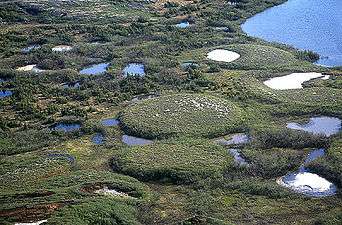 A group of palsas, as seen from above, formed by the growth of ice lenses.
A group of palsas, as seen from above, formed by the growth of ice lenses.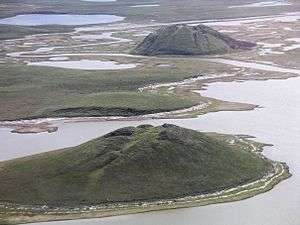 Pingos near Tuktoyaktuk, Northwest Territories, Canada
Pingos near Tuktoyaktuk, Northwest Territories, Canada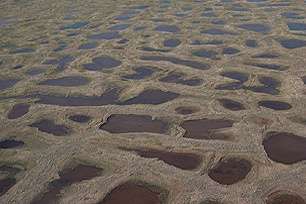 Ground polygons
Ground polygons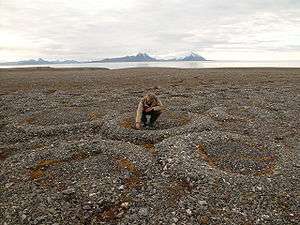 Stone rings on Spitsbergen
Stone rings on Spitsbergen Ice wedges seen from top
Ice wedges seen from top Solifluction on Svalbard
Solifluction on Svalbard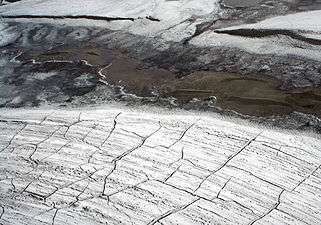 Contraction crack (ice wedge) polygons on Arctic sediment.
Contraction crack (ice wedge) polygons on Arctic sediment.- Cracks forming at the edges of the Storflaket permafrost bog in Sweden.
Carbon cycle in permafrost
The permafrost carbon cycle (Arctic Carbon Cycle) deals with the transfer of carbon from permafrost soils to terrestrial vegetation and microbes, to the atmosphere, back to vegetation, and finally back to permafrost soils through burial and sedimentation due to cryogenic processes. Some of this carbon is transferred to the ocean and other portions of the globe through the global carbon cycle. The cycle includes the exchange of carbon dioxide and methane between terrestrial components and the atmosphere, as well as the transfer of carbon between land and water as methane, dissolved organic carbon, dissolved inorganic carbon, particulate inorganic carbon and particulate organic carbon.[33]
Climate change effects
Arctic permafrost has been diminishing for many centuries. The consequence is thawing soil, which may be weaker, and release of methane, which contributes to an increased rate of global warming as part of a feedback loop caused by microbial decomposition.[34] And water draining away or evaporating into the air causing wetlands to dry up, fewer plants growing, and fewer animals would survive.[34] When permafrost continues to diminish, many climate change scenarios will be amplified. In areas where permafrost is high, the infrastructure surrounded may be damaged severely by the thawing of permafrost.[35]
Historical changes
At the Last Glacial Maximum, continuous permafrost covered a much greater area than it does today, covering all of ice-free Europe south to about Szeged (southeastern Hungary) and the Sea of Azov (then dry land)[36] and East Asia south to present-day Changchun and Abashiri.[37] In North America, only an extremely narrow belt of permafrost existed south of the ice sheet at about the latitude of New Jersey through southern Iowa and northern Missouri, but permafrost was more extensive in the drier western regions where it extended to the southern border of Idaho and Oregon.[38] In the southern hemisphere, there is some evidence for former permafrost from this period in central Otago and Argentine Patagonia, but was probably discontinuous, and is related to the tundra. Alpine permafrost also occurred in the Drakensberg during glacial maxima above about 3,000 metres (9,840 ft).[39][40]
Thaw
By definition, permafrost is ground that remains frozen for two or more years.[1] The ground can consist of many substrate materials, including bedrock, sediment, organic matter, water or ice. Frozen ground is that which is below the freezing point of water, whether or not water is present in the substrate. Ground ice is not always present, as may be the case with nonporous bedrock, but it frequently occurs and may be present in amounts exceeding the potential hydraulic saturation of the thawed substrate.
During thaw, the ice content of the soil melts and, as the water drains or evaporates, causes the soil structure to weaken and sometimes become viscous until it regains strength with decreasing moisture content. One visible sign of permafrost degradation is the random displacement of trees from their vertical orientation in permafrost areas.[41]
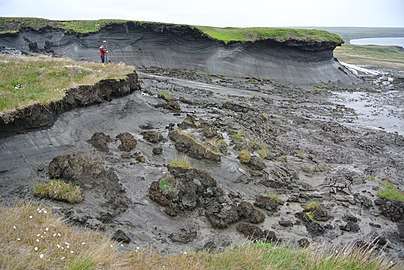 Thawing permafrost in Herschel Island, Canada, 2013
Thawing permafrost in Herschel Island, Canada, 2013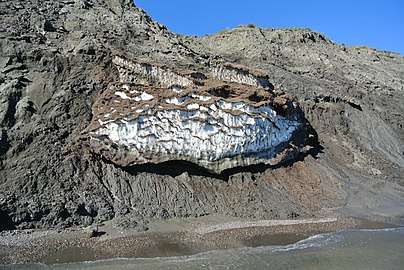 Permafrost and ice in Herschel Island, Canada, 2012
Permafrost and ice in Herschel Island, Canada, 2012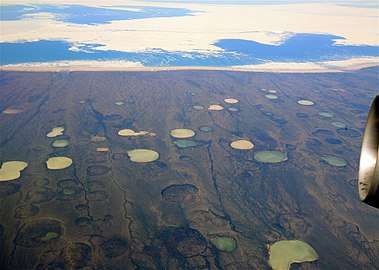 Permafrost thaw ponds on peatland in Hudson Bay, Canada in 2008.[42]
Permafrost thaw ponds on peatland in Hudson Bay, Canada in 2008.[42]
Discontinuous permafrost
The below-ground temperature varies less from season to season than the air temperature, with mean annual temperatures tending to increase with depth as a result of the geothermal crustal gradient. Thus, if the mean annual air temperature is only slightly below 0 °C (32 °F), permafrost will form only in spots that are sheltered—usually with a northern or southern aspect (in north and south hemispheres respectively) —creating discontinuous permafrost. Usually, permafrost will remain discontinuous in a climate where the mean annual soil surface temperature is between −5 and 0 °C (23 and 32 °F). In the moist-wintered areas mentioned before, there may not be even discontinuous permafrost down to −2 °C (28 °F). Discontinuous permafrost is often further divided into extensive discontinuous permafrost, where permafrost covers between 50 and 90 percent of the landscape and is usually found in areas with mean annual temperatures between −2 and −4 °C (28 and 25 °F), and sporadic permafrost, where permafrost cover is less than 50 percent of the landscape and typically occurs at mean annual temperatures between 0 and −2 °C (32 and 28 °F).[43] In soil science, the sporadic permafrost zone is abbreviated SPZ and the extensive discontinuous permafrost zone DPZ.[44] Exceptions occur in un-glaciated Siberia and Alaska where the present depth of permafrost is a relic of climatic conditions during glacial ages where winters were up to 11 °C (20 °F) colder than those of today.
Continuous permafrost
| Locality | Area (×1,000) |
|---|---|
| Qinghai-Tibet Plateau | 1,300 km2 (500 sq mi) |
| Khangai-Altai Mountains | 1,000 km2 (390 sq mi) |
| Brooks Range | 263 km2 (102 sq mi) |
| Siberian Mountains | 255 km2 (98 sq mi) |
| Greenland | 251 km2 (97 sq mi) |
| Ural Mountains | 125 km2 (48 sq mi) |
| Andes | 100 km2 (39 sq mi) |
| Rocky Mountains (US and Canada) | 100 km2 (39 sq mi) |
| Fennoscandian mountains | 75 km2 (29 sq mi) |
| Remaining | <100 km2 (39 sq mi) |
At mean annual soil surface temperatures below −5 °C (23 °F) the influence of aspect can never be sufficient to thaw permafrost and a zone of continuous permafrost (abbreviated to CPZ) forms. A line of continuous permafrost in the Northern Hemisphere[45] represents the most southern border where land is covered by continuous permafrost or glacial ice. The line of continuous permafrost varies around the world northward or southward due to regional climatic changes. In the southern hemisphere, most of the equivalent line would fall within the Southern Ocean if there were land there. Most of the Antarctic continent is overlain by glaciers, under which much of the terrain is subject to basal melting.[46] The exposed land of Antarctica is substantially underlain with permafrost,[47] some of which is subject to warming and thawing along the coastline.[48]
Effect on slope stability
Over the past century, an increasing number of alpine rock slope failure events in mountain ranges around the world have been recorded. It is expected that the high number of structural failures is due to permafrost thawing, which is thought to be linked to climate change. Permafrost thawing is thought to have contributed to the 1987 Val Pola landslide that killed 22 people in the Italian Alps.[49] In mountain ranges, much of the structural stability can be attributed to glaciers and permafrost. As climate warms, permafrost thaws, which results in a less stable mountain structure, and ultimately more slope failures.[50] Increasing temperatures allow deeper active layer depths, resulting in increased water infiltration. Ice within the soil melts, causing loss of soil strength, accelerated movement, and potential debris flows.[51]
McSaveney[52] reported massive rock and ice falls (up to 11.8 million m3), earthquakes (up to 3.9 Richter), floods (up to 7.8 million m3 water), and rapid rock-ice flow to long distances (up to 7.5 km at 60 m/s) caused by “instability of slopes” in high mountain permafrost. Instability of slopes in permafrost at elevated temperatures near freezing point in warming permafrost is related to effective stress and buildup of pore-water pressure in these soils.[53] Kia and his co-inventors[54] invented a new filter-less rigid piezometer (FRP) for measuring pore-water pressure in partially frozen soils such as warming permafrost soils. They extended the use of effective stress concept to partially frozen soils for use in slope stability analysis of warming permafrost slopes. The use of effective stress concept has many advantages such as ability to extend the concepts of "Critical State Soil Mechanics" into frozen ground engineering.
In high mountains rockfalls may be caused by thawing of rock masses with permafrost.[55]
Ecological consequences
In the northern circumpolar region, permafrost contains 1700 billion tons of organic material equaling almost half of all organic material in all soils.[8] This pool was built up over thousands of years and is only slowly degraded under the cold conditions in the Arctic. The amount of carbon sequestered in permafrost is four times the carbon that has been released to the atmosphere due to human activities in modern time.[56] One manifestation of this is yedoma, which is an organic-rich (about 2% carbon by mass) Pleistocene-age loess permafrost with ice content of 50–90% by volume.[57]
Formation of permafrost has significant consequences for ecological systems, primarily due to constraints imposed upon rooting zones, but also due to limitations on den and burrow geometries for fauna requiring subsurface homes. Secondary effects impact species dependent on plants and animals whose habitat is constrained by the permafrost. One of the most widespread examples is the dominance of black spruce in extensive permafrost areas, since this species can tolerate rooting pattern constrained to the near surface.[58]
One gram of soil from the active layer may include more than one billion bacteria cells. If placed along each other, bacteria from one kilogram of active layer soil will form a 1000 km long chain. The number of bacteria in permafrost soil varies widely, typically from 1 to 1000 million per gram of soil.[59] Most of these bacteria and fungi in permafrost soil can not be cultured in the laboratory, but the identity of the microorganisms can be revealed by DNA-based techniques.
The Arctic region is one of the many natural sources of the greenhouse gases methane and carbon dioxide.[60][61] Global warming accelerates its release due to release of methane from both existing stores and methanogenesis in rotting biomass.[62] Large quantities of methane are stored in the Arctic in natural gas deposits, in permafrost, and as submarine clathrates. Permafrost and clathrates degrade on warming, and thus, large releases of methane from these sources may arise as a result of global warming.[63][64][65][66] Other sources of methane include submarine taliks, river transport, ice complex retreat, submarine permafrost, and decaying gas hydrate deposits.[67] Preliminary computer analyses suggest that permafrost could produce carbon equal to 15 percent or so of today's emissions from human activities.[68]
A hypothesis forwarded by Sergey Zimov is that the reduction of herds of large herbivores has increased the ratio of energy emission and energy absorption tundra (energy balance) in a manner that increases the tendency for net thawing of permafrost.[69] He is testing this hypothesis in an experiment at Pleistocene Park, a nature reserve in northeastern Siberia.[70]
Predicted rate of change in the Arctic
According to IPCC Fifth Assessment Report there is high confidence that permafrost temperatures have increased in most regions since the early 1980s. Observed warming was up to 3 °C in parts of Northern Alaska (early 1980s to mid-2000s) and up to 2 °C in parts of the Russian European North (1971–2010).[71] In Yukon, the zone of continuous permafrost might have moved 100 kilometres (62 mi) poleward since 1899, but accurate records only go back 30 years. It is thought that permafrost thawing could exacerbate global warming by releasing methane and other hydrocarbons, which are powerful greenhouse gases.[66][72][73][74] It also could encourage erosion because permafrost lends stability to barren Arctic slopes.[75]
Arctic temperatures are expected to increase at roughly twice the global rate.[76] The Intergovernmental Panel on Climate Change (IPCC) will in their fifth report establish scenarios for the future, where the temperature in the Arctic will rise between 1.5 and 2.5 °C by 2040 and with 2 to 7.5 °C by 2100. Estimates vary on how many tons of greenhouse gases are emitted from thawed permafrost soils.[77] One estimate suggests that 110–231 billion tons of CO2 equivalents (about half from carbon dioxide and the other half from methane) will be emitted by 2040, and 850–1400 billion tons by 2100.[56] This corresponds to an average annual emission rate of 4–8 billion tons of CO2 equivalents in the period 2011–2040 and annually 10–16 billion tons of CO2 equivalents in the period 2011–2100 as a result of thawing permafrost. For comparison, the anthropogenic emission of all greenhouse gases in 2010 is approximately 48 billion tons of CO2 equivalents.[78] Release of greenhouse gases from thawed permafrost to the atmosphere increases global warming.[79][80]
Preservation of organisms in permafrost
Microbes
Scientists predict that up to 1021 microbes, including fungi and bacteria in addition to viruses, will be released from melting ice per year. Often, these microbes will be released directly into the ocean. Due to the migratory nature of many species of fish and birds, it is possible that these microbes have a high transmission rate.[81]
Permafrost in eastern Switzerland was analyzed by researchers in 2016 at an alpine permafrost site called “Muot-da-Barba-Peider”.This site had a diverse microbial community with various bacteria and eukaryotic groups present. Prominent bacteria groups included phylum Acidobacteria, Actinobacteria, AD3, Bacteroidetes, Chloroflexi, Gemmatimonadetes, OD1, Nitrospirae, Planctomycetes, Proteobacteria, and Verrucomicrobia. Prominent eukaryotic fungi included Ascomycota, Basidiomycota, and Zygomycota. In the present species, scientists observed a variety of adaptations for sub-zero conditions, including reduced and anaerobic metabolic processes.[82]
A 2016 outbreak of anthrax in the Yamal Peninsula is believed to be due to thawing permafrost.[83] Also present in Siberian permafrost are two species of virus: Pithovirus sibericum [84]and Mollivirus sibericum.[85] Both of these are approximately 30,000 years old and considered giant viruses due to the fact that they are larger in size than most bacteria and have genomes larger than other viruses. Both viruses are still infective, as seen by their ability to infect Acanthamoeba, a genus of amoebas.[85]
Freezing at low temperatures has been shown to preserve the infectivity of viruses. Caliciviruses, influenza A, and enteroviruses (ex. Polioviruses, echoviruses, Coxsackie viruses) have all been preserved in ice and/or permafrost. Scientists have determined three characteristics necessary for a virus to successfully preserve in ice: high abundance, ability to transport in ice, and ability to resume disease cycles upon being released from ice. A direct infection from permafrost or ice to humans has not been demonstrated; such viruses are typically spread through other organisms or abiotic mechanisms.[81]
A study of late Pleistocene Siberian permafrost samples from Kolyma Lowland (an east siberian lowland) used DNA isolation and gene cloning (specifically 16S rRNA genes) to determine which phyla these microorganisms belonged to. This technique allowed a comparison of known microorganisms to their newly discovered samples and revealed eight phylotypes, which belonged to the phyla Actinobacteria and Proteobacteria.[86]
Plants
In 2012, Russian researchers proved that permafrost can serve as a natural repository for ancient life forms by reviving of Silene stenophylla from 30,000 year old tissue found in an Ice Age squirrel burrow in the Siberian permafrost. This is the oldest plant tissue ever revived. The plant was fertile, producing white flowers and viable seeds. The study demonstrated that tissue can survive ice preservation for tens of thousands of years.[87]
Other issues
The International Permafrost Association (IPA) is an integrator of issues regarding permafrost. It convenes International Permafrost Conferences, undertakes special projects such as preparing databases, maps, bibliographies, and glossaries, and coordinates international field programmes and networks. Among other issues addressed by the IPA are: Problems for construction on permafrost owing to the change of soil properties of the ground on which structures are placed and the biological processes in permafrost, e.g. the preservation of organisms frozen in situ.
Construction on permafrost
Building on permafrost is difficult because the heat of the building (or pipeline) can warm the permafrost and destabilize the structure. Warming can result in thawing of the soil and its consequent weakening of support for a structure as the ice content turns to water; alternatively, where structures are built on piles, warming can cause movement through creep because of the change of friction on the piles even as the soil remains frozen.[88]
Three common solutions include: using foundations on wood piles; building on a thick gravel pad (usually 1–2 metres/3.3–6.6 feet thick); or using anhydrous ammonia heat pipes.[89] The Trans-Alaska Pipeline System uses heat pipes built into vertical supports to prevent the pipeline from sinking and the Qingzang railway in Tibet employs a variety of methods to keep the ground cool, both in areas with frost-susceptible soil. Permafrost may necessitate special enclosures for buried utilities, called "utilidors".[90]
The Melnikov Permafrost Institute in Yakutsk, found that the sinking of large buildings into the ground can be prevented by using pile foundations extending down to 15 metres (49 ft) or more. At this depth the temperature does not change with the seasons, remaining at about −5 °C (23 °F).[91]
- Modern buildings in permafrost zones may be built on piles to avoid permafrost-thaw foundation failure from the heat of the building.
.jpg) Heat pipes in vertical supports maintain a frozen bulb around portions of the Trans-Alaska Pipeline that are at risk of thawing.
Heat pipes in vertical supports maintain a frozen bulb around portions of the Trans-Alaska Pipeline that are at risk of thawing.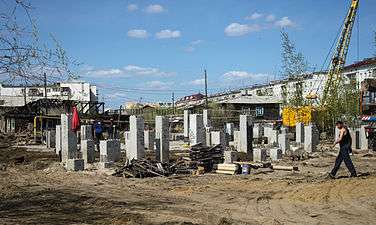 Pile foundations in Yakutsk, a city underlain with continuous permafrost.
Pile foundations in Yakutsk, a city underlain with continuous permafrost.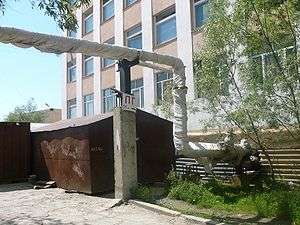 District heating pipes run above ground in Yakutsk to avoid thawing permafrost.
District heating pipes run above ground in Yakutsk to avoid thawing permafrost.
See also
- Global Terrestrial Network for Permafrost
References
- Doyle, Heather (April 9, 2020). "What Is Permafrost?". NASA Climate Kids. Retrieved 2020-04-16.
- Walker, H. Jesse (December 2010). "Frozen in Time. Permafrost and Engineering Problems Review". Arctic. 63 (4): 477. doi:10.14430/arctic3340.
- Ray, Luis L. "Permafrost - USGS [=United States Geological Survey] Library Publications Warehouse" (PDF). Archived (PDF) from the original on 2017-05-02. Retrieved November 19, 2018.
- U.S. Geological Survey; United States. Army. Corps of Engineers. Strategic Intelligence Branch (1943). "Permafrost or permanently frozen ground and related engineering problems". Strategic Engineering Study (62): 231. OCLC 22879846.
- Occurrences on Google Books.
- Muller, Siemon William (1947). Permafrost. Or, Permanently Frozen Ground and Related Engineering Problems. Ann Arbor, Michigan: Edwards. OCLC 1646047.
- Staff (2014). "What is Permafrost?". International Permafrost Association. Archived from the original on 2014-11-08. Retrieved 2014-02-28.
- Tarnocai; et al. (2009). "Soil organic carbon pools in the northern circumpolar permafrost region". Global Biogeochemical Cycles. 23 (2): GB2023. Bibcode:2009GBioC..23.2023T. doi:10.1029/2008gb003327.
- Heginbottom, J. Alan, Brown, Jerry; Humlum, Ole and Svensson, Harald; ‘State of the Earth’s Cryosphere at the Beginning of the 21st Century: Glaciers, Global Snow Cover, Floating Ice, and Permafrost and Periglacial Environments’, p. A435
- Delisle, G. (2007). "Near-surface permafrost degradation: How severe during the 21st century?". Geophysical Research Letters. 34 (L09503): 4. Bibcode:2007GeoRL..34.9503D. doi:10.1029/2007GL029323.
- Sharp, Robert Phillip (1988). Living Ice: Understanding Glaciers and Glaciation. Cambridge University Press. p. 27. ISBN 978-0-521-33009-1.
- Majorowicz, Jacek (2012), "Permafrost at the ice base of recent pleistocene glaciations – Inferences from borehole temperatures profiles", Bulletin of Geography. Physical Geography Series, Physical Geography Series, 5: 7–28, doi:10.2478/v10250-012-0001-x
- "Alpine permafrost". Encyclopedia Britannica. Retrieved 2020-04-16.
- Bockheim, James G.; Munroe, Jeffrey S. (2014), "Organic carbon pools and genesis of alpine soils with permafrost: a review" (PDF), Arctic, Antarctic, and Alpine Research, 46 (4): 987–1006, doi:10.1657/1938-4246-46.4.987, archived (PDF) from the original on 2016-09-23, retrieved 2016-04-25
- Azocar, Guillermo (2014), Modeling of Permafrost Distribution in the Semi-arid Chilean Andes, Waterloo, Ontario: University of Waterloo, archived from the original on 2016-05-30, retrieved 2016-04-24
- Ruiz, Lucas; Liaudat, Dario Trombotto (2012), Mountain Permafrost Distribution in the Andes of Chubut (Argentina) Based on a Statistical Model (PDF), Tenth International Conference on Permafrost, Mendoza, Argentina: Instituto Argentino de Nivología Glaciología y Ciencias Ambientales, pp. 365–370, archived (PDF) from the original on 2016-05-13, retrieved 2016-04-24
- Rozell, Ned (November 18, 2009), "Permafrost near equator; hummingbirds near subarctic", Capitol City Weekly, Juneau, Alaska
- Editors (2014). "What is Permafrost?". International Permafrost Association. Archived from the original on 2014-11-08. Retrieved 2014-11-08.CS1 maint: extra text: authors list (link)
- Osterkamp, T. E. (2001), "Sub-Sea Permafrost", Encyclopedia of Ocean Sciences, pp. 2902–12, doi:10.1006/rwos.2001.0008, ISBN 9780122274305
- IPCC AR4 (2007). "Climate Change 2007: Working Group I: The Physical Science Basis". Retrieved April 12, 2014.CS1 maint: uses authors parameter (link)
- Lunardini 1995, p. 35 Table Dl. Freeze at Prudhoe Bay, Alaska.
- Osterkamp, T.E.; Burn, C.R. (2014-09-14), "Permafrost", in North, Gerald R.; Pyle, John A.; Zhang, Fuqing (eds.), Encyclopedia of Atmospheric Sciences (PDF), 4, Elsevier, pp. 1717–1729, ISBN 978-0123822260, archived (PDF) from the original on 2016-11-30, retrieved 2016-03-08
- Desonie, Dana (2008). Polar Regions: Human Impacts. New York: Chelsea Press. ISBN 978-0-8160-6218-8.
- Fridleifsson, Ingvar B.; Bertani, Ruggero; Huenges, Ernst; Lund, John W.; Ragnarsson, Arni; Rybach, Ladislaus (2008-02-11). O. Hohmeyer and T. Trittin (ed.). "The possible role and contribution of geothermal energy to the mitigation of climate change" (PDF). Luebeck, Germany: 59–80. Archived (PDF) from the original on 2013-03-12. Retrieved 2013-11-03. Cite journal requires
|journal=(help) - Lunardini, Virgil J. (April 1995). "Permafrost Formation Time" (PDF). CRREL Report 95-8. Hanover NH: US Army Corps of Engineers Cold Regions Research and Engineering Laboratory. p. 18. ADA295515. Archived from the original on 2013-04-08. Retrieved 2012-03-03.CS1 maint: ref=harv (link)
- Mackay, J. Ross (1973), "Problems in the origins of massive icy beds, Western Arctic, Canada", Permafrost: North American Contribution – Second International Conference, 2: 223–8
- French, H.M. (2007). The Periglacial Environment (3 ed.). Chichester: Wiley.
- Shumskiy, P.A.; Vtyurin, B.I. (1963), "Underground ice", Permafrost International Conference (1287): 108–13
- Mackay, J.R.; Dallimore, S.R. (1992), "Massive ice of Tuktoyaktuk area, Western Arctic coast, Canada", Canadian Journal of Earth Sciences, 29 (6): 1234–42, Bibcode:1992CaJES..29.1235M, doi:10.1139/e92-099
- Astakhov, 1986; Kaplanskaya and Tarnogradskiy, 1986; Astakhov and Isayeva, 1988; French, 1990; Lacelle et al., 2009
- Pidwirny, M (2006). "Periglacial Processes and Landforms". Fundamentals of Physical Geography.
- Kessler MA, Werner BT (January 2003). "Self-organization of sorted patterned ground". Science. 299 (5605): 380–3. Bibcode:2003Sci...299..380K. doi:10.1126/science.1077309. PMID 12532013.
- McGuire, A.D., Anderson, L.G., Christensen, T.R., Dallimore, S., Guo, L., Hayes, D.J., Heimann, M., Lorenson, T.D., Macdonald, R.W., and Roulet, N. (2009). "Sensitivity of the carbon cycle in the Arctic to climate change". Ecological Monographs. 79 (4): 523–555. doi:10.1890/08-2025.1. hdl:11858/00-001M-0000-000E-D87B-C.CS1 maint: multiple names: authors list (link)
- Koven, Charles D.; Riley, William J.; Stern, Alex (2012-10-01). "Analysis of Permafrost Thermal Dynamics and Response to Climate Change in the CMIP5 Earth System Models". Journal of Climate. 26 (6): 1877–1900. doi:10.1175/JCLI-D-12-00228.1. ISSN 0894-8755.
- Nelson, F. E.; Anisimov, O. A.; Shiklomanov, N. I. (2002-07-01). "Climate Change and Hazard Zonation in the Circum-Arctic Permafrost Regions". Natural Hazards. 26 (3): 203–225. doi:10.1023/A:1015612918401. ISSN 1573-0840.
- Sidorchuk, Aleksey, Borisova Olga and Panin; Andrey; “Fluvial response to the late Valdai/Holocene environmental change on the East European plain” Archived 2013-12-26 at the Wayback Machine
- Yugo Ono and Tomohisa Irino; “Southern migration of westerlies in the Northern Hemisphere PEP II transect during the Last Glacial Maximum” in Quaternary International 118–119 (2004); pp. 13–22
- Malde, H.E.; “Patterned Ground in the Western Snake River Plain, Idaho, and Its Possible Cold-Climate Origin”; in Geological society of America Bulletin; v. 75 no. 3 (March 1964); pp. 191–208
- Grab, Stefan; “Characteristics and palaeoenvironmental significance of relict sorted patterned ground, Drakensberg plateau, southern Africa” in Quaternary Science Reviews, vol. 21, issues 14–15, (August 2002), pp. 1729–1744
- "Inventory of fossil cryogenic forms and structures in Patagonia and the mountains of Argentina beyond the Andes". South African Journal of Science, 98: 171–180, Review Articles, Pretoria, Sudáfrica.
- Huissteden, J. van (2020). Thawing Permafrost: Permafrost Carbon in a Warming Arctic. Springer Nature. p. 296. ISBN 978-3-030-31379-1.
- Larry D. Dyke, Wendy E. Sladen (2010). "Permafrost and Peatland Evolution in the Northern Hudson Bay Lowland, Manitoba". ARCTIC. 63 (4). doi:10.14430/arctic3332. Archived from the original on 2014-08-10. Retrieved 2014-08-02.CS1 maint: uses authors parameter (link)
- Brown, Roger J.E.; Péwé, Troy L. (1973), "Distribution of permafrost in North America and its relationship to the environment: A review, 1963–1973", Permafrost: North American Contribution – Second International Conference, 2: 71–100
- Robinson, S.D.; et al. (2003), "Permafrost and peatland carbon sink capacity with increasing latitude", in Phillips; et al. (eds.), Permafrost (PDF), Swets & Zeitlinger, pp. 965–970, ISBN 90-5809-582-7, archived (PDF) from the original on 2014-03-02, retrieved 2014-03-02
- Andersland, Orlando B.; Ladanyi, Branko (2004). Frozen ground engineering (2nd ed.). Wiley. p. 5. ISBN 978-0-471-61549-1.
- Zoltikov, I.A. (1962), "Heat regime of the central Antarctic glacier", Antarctica, Reports of the Commission, 1961 (in Russian): 27–40
- Campbell, Iain B.; Claridge, Graeme G. C. (2009), "Antarctic Permafrost Soils", in Margesin, Rosa (ed.), Permafrost Soils, Soil Biology, 16, Berlin: Springer, pp. 17–31, doi:10.1007/978-3-540-69371-0_2, ISBN 978-3-540-69370-3
- Heinrich, Holly (July 25, 2013), "Permafrost Melting Faster Than Expected in Antarctica", National Public Radio, archived from the original on 2016-05-03, retrieved 2016-04-23
- F., Dramis; M., Govi; M., Guglielmin; G., Mortara (1995-01-01). "Mountain permafrost and slope instability in the Italian Alps: The Val Pola Landslide". Permafrost and Periglacial Processes. 6 (1): 73–81. doi:10.1002/ppp.3430060108. ISSN 1099-1530.
- Huggel, C.; Allen, S.; Deline, P.; et al. (June 2012), "Ice thawing, mountains falling; are alpine rock slope failures increasing?", Geology Today, 28 (3): 98–104, doi:10.1111/j.1365-2451.2012.00836.x
- Darrow, M.; Gyswyt, N.; Simpson, J.; Daanen, R.; Hubbard, T.; et al. (May 2016), "Frozen debris lobe morphology and movement: an overview of eight dynamic features, southern Brooks Range, Alaska" (PDF), The Cryosphere, 10 (3): 977–993, Bibcode:2016TCry...10..977D, doi:10.5194/tc-10-977-2016
- McSaveney, M.J. (2002). Recent rockfalls and rock avalanches in Mount Cook national park, New Zealand. In Catastrophic landslides, effects, occurrence and mechanisms. Boulder: Geological Society of America, Reviews in Engineering Geology, Volume XV. pp. 35–70. ISBN 9780813758152. Archived from the original on 2018-01-28. Retrieved 2018-01-27.
- Nater, P.; Arenson, L.U.; Springman, S.M. (2008). Choosing geotechnical parameters for slope stability assessments in alpine permafrost soils. In 9th international conference on permafrost. Fairbanks, USA: University of Alaska. pp. 1261–1266. ISBN 9780980017939.
- Kia, Mohammadali; Sego, David Charles; Morgenstern, Norbert Rubin. "FRP: Filter-less Rigid Piezometer for Measuring Pore-Water Pressure in Partially Frozen Soils". Alpha Adroit Engineering Ltd. Alpha Adroit Engineering Ltd. Archived from the original on 2018-01-28. Retrieved 27 January 2018.
- Temme, Arnaud J. A. M. (2015). "Using Climber's Guidebooks to Assess Rock Fall Patterns Over Large Spatial and Decadal Temporal Scales: An Example from the Swiss Alps". Geografiska Annaler: Series A, Physical Geography. 97 (4): 793–807. doi:10.1111/geoa.12116. ISSN 1468-0459.
- Schuur; et al. (2011). "High risk of permafrost thaw". Nature. 480 (7375): 32–33. Bibcode:2011Natur.480...32S. doi:10.1038/480032a. PMID 22129707.
- Walter KM, Zimov SA, Chanton JP, Verbyla D, Chapin FS (September 2006). "Methane bubbling from Siberian thaw lakes as a positive feedback to climate warming". Nature. 443 (7107): 71–5. Bibcode:2006Natur.443...71W. doi:10.1038/nature05040. PMID 16957728.
- C. Michael Hogan, Black Spruce: Picea mariana, GlobalTwitcher.com, ed. Nicklas Stromberg, November, 2008 Archived 2011-10-05 at the Wayback Machine
- Hansen; et al. (2007). "Viability, diversity and composition of the bacterial community in a high Arctic permafrost soil from Spitsbergen, Northern Norway". Environmental Microbiology. 9 (11): 2870–2884. doi:10.1111/j.1462-2920.2007.01403.x. PMID 17922769. – and additional references in this paper. Yergeau; et al. (2010). "The functional potential of high Arctic permafrost revealed by metagenomic sequencing, qPCR and microarray analyses". The ISME Journal. 4 (9): 1206–1214. doi:10.1038/ismej.2010.41. PMID 20393573.
- Bloom, A. A.; Palmer, P. I.; Fraser, A.; Reay, D. S.; Frankenberg, C. (2010). "Large-Scale Controls of Methanogenesis Inferred from Methane and Gravity Spaceborne Data" (PDF). Science. 327 (5963): 322–325. Bibcode:2010Sci...327..322B. doi:10.1126/science.1175176. PMID 20075250.
- Natali, Susan M.; Watts, Jennifer D.; Rogers, Brendan M.; Potter, Stefano; Ludwig, Sarah M.; Selbmann, Anne-Katrin; Sullivan, Patrick F.; Abbott, Benjamin W.; Arndt, Kyle A.; Birch, Leah; Björkman, Mats P. (2019-10-21). "Large loss of CO 2 in winter observed across the northern permafrost region". Nature Climate Change. 9 (11): 852–857. Bibcode:2019NatCC...9..852N. doi:10.1038/s41558-019-0592-8. ISSN 1758-6798.
- Walter, K. M.; Chanton, J. P.; Chapin, F. S.; Schuur, E. A. G.; Zimov, S. A. (2008). "Methane production and bubble emissions from arctic lakes: Isotopic implications for source pathways and ages". Journal of Geophysical Research. 113: G00A08. Bibcode:2008JGRG..11300A08W. doi:10.1029/2007JG000569.
- Zimov, Sa; Schuur, Ea; Chapin, Fs, 3Rd (Jun 2006). "Climate change. Permafrost and the global carbon budget". Science. 312 (5780): 1612–3. doi:10.1126/science.1128908. ISSN 0036-8075. PMID 16778046.CS1 maint: multiple names: authors list (link)
- Shakhova, Natalia (2005). "The distribution of methane on the Siberian Arctic shelves: Implications for the marine methane cycle". Geophysical Research Letters. 32 (9): L09601. Bibcode:2005GeoRL..32.9601S. doi:10.1029/2005GL022751.
- Pfeiffer, Eva-Maria; Grigoriev, Mikhail N.; Liebner, Susanne; Beer, Christian; Knoblauch, Christian (April 2018). "Methane production as key to the greenhouse gas budget of thawing permafrost". Nature Climate Change. 8 (4): 309–312. Bibcode:2018NatCC...8..309K. doi:10.1038/s41558-018-0095-z. ISSN 1758-6798.
- Reuters (2019-06-18). "Scientists shocked by Arctic permafrost thawing 70 years sooner than predicted". The Guardian. ISSN 0261-3077. Retrieved 2019-07-02.
- Shakhova, Natalia; Semiletov, Igor (2007). "Methane release and coastal environment in the East Siberian Arctic shelf". Journal of Marine Systems. 66 (1–4): 227–243. Bibcode:2007JMS....66..227S. CiteSeerX 10.1.1.371.4677. doi:10.1016/j.jmarsys.2006.06.006.
- Gillis, Justin (December 16, 2011). "As Permafrost Thaws, Scientists Study the Risks". The New York Times. Archived from the original on 2017-05-19. Retrieved 2017-02-11.
- S.A. Zimov, N.S. Zimov, A.N. Tikhonov, F.S. Chapin III (2012). "Mammoth steppe: a high-productivity phenomenon" (PDF). In: Quaternary Science Reviews, vol. 57, 4 December 2012, p. 42 fig.17. Archived from the original (PDF) on 4 March 2016. Retrieved 17 October 2014.CS1 maint: multiple names: authors list (link)
- Sergey A. Zimov (6 May 2005): "Pleistocene Park: Return of the Mammoth's Ecosystem." Archived 2017-02-20 at the Wayback Machine In: Science, pages 796–798. Article also to be found in www.pleistocenepark.ru/en/ – Materials. Archived 2016-11-03 at the Wayback Machine Retrieved 5 May 2013.
- "Working Group I Contribution to the IPCC Fifth Assessment Report Climate Change 2013 - Summary for Policymakers - Template Lab". 10 November 2015. Archived from the original on 2017-01-18. Retrieved 2017-01-16.
- Sample, Ian (11 August 2005). "Warming hits 'tipping point'". The Guardian. Archived from the original on 2016-08-26. Retrieved 2016-12-12. ]
- Schuur, E.A.G.; Vogel1, J.G.; Crummer, K.G.; Lee, H.; Sickman J.O.; Osterkamp T.E. (28 May 2009). "The effect of permafrost thaw on old carbon release and net carbon exchange from tundra". Nature. 459 (7246): 556–9. Bibcode:2009Natur.459..556S. doi:10.1038/nature08031. PMID 19478781.
- "Thaw point". The Economist. 30 July 2009. Archived from the original on 2011-02-26. Retrieved 2010-11-17.
- Turetsky, Merritt R. (2019-04-30). "Permafrost collapse is accelerating carbon release". Nature. 569 (7754): 32–34. Bibcode:2019Natur.569...32T. doi:10.1038/d41586-019-01313-4. PMID 31040419.
- IPCC 2007. Summary for policy makers. In: Climate Change 2007: The physical basis. Working group I contribution to the fourth assessment report of the Intergovernmental Panel on Climate Change (eds. Solomon et al.). Cambridge University Press, Cambridge, UK.
- "Arctic permafrost is thawing fast. That affects us all". National Geographic. 2019-08-13. Retrieved 2019-08-17.
- UNEP 2011. Bridging the Emissions Gap. A UNEP Synthesis Report. 56 p. UNEP, Nairobi, Kenya
- Comyn-Platt, Edward (2018). "Carbon budgets for 1.5 and 2 °C targets lowered by natural wetland and permafrost feedbacks". Nature Geoscience. 11 (8): 568–573. Bibcode:2018NatGe..11..568C. doi:10.1038/s41561-018-0174-9.
- Turetsky, Merritt R.; Abbott, Benjamin W.; Jones, Miriam C.; Anthony, Katey Walter; Olefeldt, David; Schuur, Edward A. G.; Grosse, Guido; Kuhry, Peter; Hugelius, Gustaf; Koven, Charles; Lawrence, David M. (2020-02-03). "Carbon release through abrupt permafrost thaw". Nature Geoscience. 13 (2): 138–143. Bibcode:2020NatGe..13..138T. doi:10.1038/s41561-019-0526-0. ISSN 1752-0908.
- Smith, Alvin W.; Skilling, Douglas E.; Castello, John D.; Rogers, Scott O. (2004-01-01). "Ice as a reservoir for pathogenic human viruses: specifically, caliciviruses, influenza viruses, and enteroviruses". Medical Hypotheses. 63 (4): 560–566. doi:10.1016/j.mehy.2004.05.011. ISSN 0306-9877. PMID 15324997.
- Frey, Beat; Rime, Thomas; Phillips, Marcia; Stierli, Beat; Hajdas, Irka; Widmer, Franco; Hartmann, Martin (March 2016). Margesin, Rosa (ed.). "Microbial diversity in European alpine permafrost and active layers". FEMS Microbiology Ecology. 92 (3): fiw018. doi:10.1093/femsec/fiw018. ISSN 1574-6941. PMID 26832204.
- "Anthrax Outbreak In Russia Thought To Be Result Of Thawing Permafrost". Archived from the original on 2016-09-22. Retrieved 2016-09-24.
- Legendre, Matthieu; Bartoli, Julia; Shmakova, Lyubov; Jeudy, Sandra; Labadie, Karine; Adrait, Annie; Lescot, Magali; Poirot, Olivier; Bertaux, Lionel; Bruley, Christophe; Couté, Yohann (2014). "Thirty-thousand-year-old distant relative of giant icosahedral DNA viruses with a pandoravirus morphology". Proceedings of the National Academy of Sciences of the United States of America. 111 (11): 4274–4279. Bibcode:2014PNAS..111.4274L. doi:10.1073/pnas.1320670111. ISSN 0027-8424. JSTOR 23771019. PMC 3964051. PMID 24591590.
- Legendre, Matthieu; Lartigue, Audrey; Bertaux, Lionel; Jeudy, Sandra; Bartoli, Julia; Lescot, Magali; Alempic, Jean-Marie; Ramus, Claire; Bruley, Christophe; Labadie, Karine; Shmakova, Lyubov (2015). "In-depth study of Mollivirus sibericum, a new 30,000-y-old giant virus infecting Acanthamoeba". Proceedings of the National Academy of Sciences of the United States of America. 112 (38): E5327–E5335. Bibcode:2015PNAS..112E5327L. doi:10.1073/pnas.1510795112. ISSN 0027-8424. JSTOR 26465169. PMC 4586845. PMID 26351664.
- Kudryashova, E. B.; Chernousova, E. Yu.; Suzina, N. E.; Ariskina, E. V.; Gilichinsky, D. A. (2013-05-01). "Microbial diversity of Late Pleistocene Siberian permafrost samples". Microbiology. 82 (3): 341–351. doi:10.1134/S0026261713020082. ISSN 1608-3237.
- Isachenkov, Vladimir (February 20, 2012), "Russians revive Ice Age flower from frozen burrow", Phys.Org, archived from the original on 2016-04-24, retrieved 2016-04-26
- Fang, Hsai-Yang (1990-12-31). Foundation Engineering Handbook. Springer Science & Business Media. p. 735. ISBN 978-0-412-98891-2.
- Clarke, Edwin S. (2007). Permafrost Foundations—State of the Practice. Monograph Series. American Society of Civil Engineers. ISBN 978-0-7844-0947-3.
- Woods, Kenneth B. (1966). Permafrost International Conference: Proceedings. National Academies. pp. 418–57.
- Sanger, Frederick J.; Hyde, Peter J. (1978-01-01). Permafrost: Second International Conference, July 13-28, 1973 : USSR Contribution. National Academies. p. 786.
External links
| Look up permafrost in Wiktionary, the free dictionary. |
| Wikimedia Commons has media related to Permafrost. |
- Permafrostwatch University of Alaska Fairbanks
- Infographics about permafrost
- International Permafrost Association (IPA)
- Center for Permafrost
- Map of permafrost in Antarctica.
- Permafrost – what is it? – YouTube (Alfred Wegener Institute)